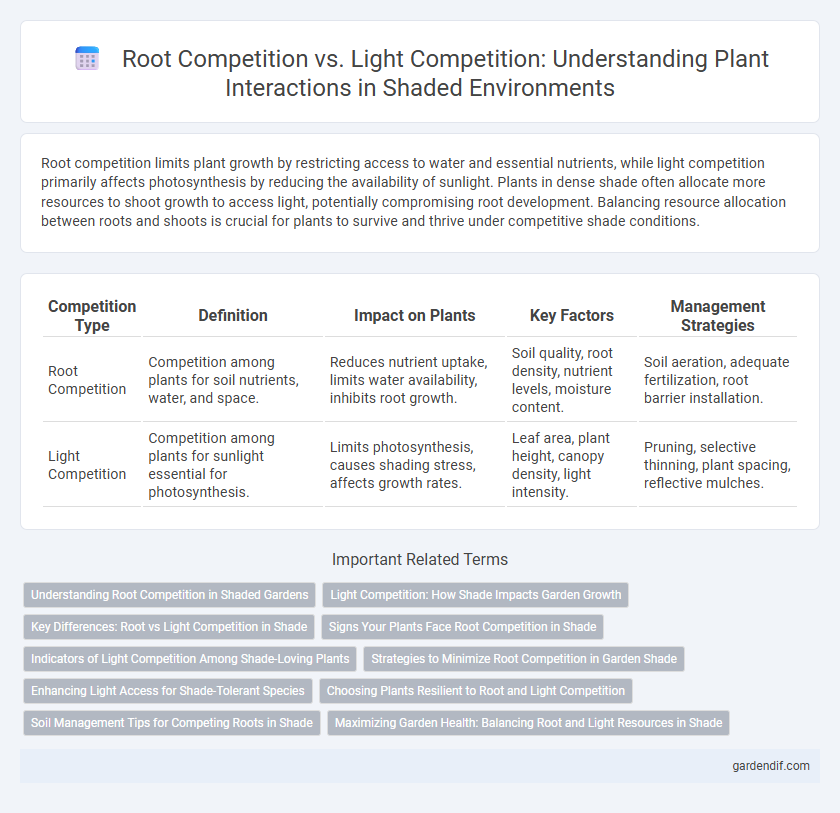
Root Competition vs Light Competition Illustration
Root competition limits plant growth by restricting access to water and essential nutrients, while light competition primarily affects photosynthesis by reducing the availability of sunlight. Plants in dense shade often allocate more resources to shoot growth to access light, potentially compromising root development. Balancing resource allocation between roots and shoots is crucial for plants to survive and thrive under competitive shade conditions.
Table of Comparison
| Competition Type | Definition | Impact on Plants | Key Factors | Management Strategies |
|---|---|---|---|---|
| Root Competition | Competition among plants for soil nutrients, water, and space. | Reduces nutrient uptake, limits water availability, inhibits root growth. | Soil quality, root density, nutrient levels, moisture content. | Soil aeration, adequate fertilization, root barrier installation. |
| Light Competition | Competition among plants for sunlight essential for photosynthesis. | Limits photosynthesis, causes shading stress, affects growth rates. | Leaf area, plant height, canopy density, light intensity. | Pruning, selective thinning, plant spacing, reflective mulches. |
Understanding Root Competition in Shaded Gardens
In shaded gardens, root competition plays a critical role as plants compete for limited soil nutrients and water beneath the surface, often intensified by reduced photosynthesis due to low light. Studies indicate that root systems expand more aggressively in shaded environments to maximize resource uptake, contrasting with light competition where plants adapt by elongating stems or adjusting leaf angles to capture available sunlight. Effective garden management requires selecting species with complementary root structures to minimize underground competition and ensure balanced growth despite shade conditions.
Light Competition: How Shade Impacts Garden Growth
Light competition in gardens directly influences plant growth by limiting the availability of sunlight necessary for photosynthesis, causing shaded plants to exhibit reduced vigor and slower development. Plants in shaded areas often adapt by elongating stems and enlarging leaves to capture more light, though this can lead to weaker structures and increased susceptibility to disease. Effective garden management involves strategically placing sun-loving species in high-light zones and selecting shade-tolerant plants for low-light areas to optimize overall growth and ecosystem balance.
Key Differences: Root vs Light Competition in Shade
Root competition in shade primarily involves the struggle among plants for limited belowground resources such as water and nutrients, often intensified by dense root systems overlapping in shaded environments. Light competition, on the other hand, centers on aboveground challenges where plants compete for sunlight, leading to morphological adaptations like elongated stems and larger leaves to capture scarce light under canopy cover. The key difference lies in resource type and acquisition strategy: root competition targets soil nutrients and moisture, while light competition focuses on maximizing photosynthetic input through structural changes.
Signs Your Plants Face Root Competition in Shade
Plants facing root competition in shaded environments often exhibit stunted growth and yellowing leaves due to nutrient scarcity. Unlike light competition signs such as elongated stems or reduced leaf size, root competition symptoms include poor root development and weakened overall plant vigor. Monitoring soil moisture and nutrient levels can help identify and mitigate root competition stress for healthy plant growth.
Indicators of Light Competition Among Shade-Loving Plants
Shade-loving plants exhibit specific indicators of light competition, such as elongated stems, enlarged leaves, and increased chlorophyll concentration to maximize light absorption. These morphological adaptations allow them to optimize photosynthesis under low light conditions, differentiating from root competition which primarily involves nutrient and water uptake. Monitoring changes in leaf angle and stem elongation rates provides clear evidence of light competition dynamics in shaded environments.
Strategies to Minimize Root Competition in Garden Shade
Minimizing root competition in garden shade involves selecting deep-rooted plant species that access nutrients and water from lower soil layers, leaving surface resources available for shallow-rooted neighbors. Implementing raised beds or container planting can physically separate root zones, reducing overlap and competition. Applying organic mulch improves soil structure and moisture retention, promoting healthier root growth and minimizing direct resource competition among shaded plants.
Enhancing Light Access for Shade-Tolerant Species
Root competition primarily limits nutrient and water availability, while light competition directly restricts photosynthesis, crucial for shade-tolerant species' growth. Enhancing light access through strategic pruning or selective thinning improves the canopy's light quality and intensity, optimizing photosynthetic efficiency. Shade-tolerant plants benefit from increased diffuse light, which reduces photoinhibition and promotes sustained growth under shaded conditions.
Choosing Plants Resilient to Root and Light Competition
Choosing plants resilient to root and light competition enhances garden productivity by ensuring optimal resource utilization. Species such as native ferns and shade-tolerant grasses exhibit strong adaptations to low light conditions while efficiently sharing root space with neighboring plants. Incorporating these resilient plants minimizes growth inhibition caused by overlapping root zones and canopy shading, fostering a thriving, balanced ecosystem.
Soil Management Tips for Competing Roots in Shade
Effective soil management in shaded areas prioritizes enhancing nutrient availability and improving soil structure to mitigate root competition. Applying organic mulch supports moisture retention and encourages beneficial microbial activity, which is crucial for root health where light access is limited. Incorporating deep-rooting cover crops and careful aeration promotes root expansion and reduces competition among plants competing for scarce soil resources under shade.
Maximizing Garden Health: Balancing Root and Light Resources in Shade
Managing root competition and light competition is essential for maximizing garden health in shaded environments. Optimizing root space allocation increases nutrient and water uptake while ensuring sufficient light penetration supports photosynthesis and growth. Balancing these factors reduces stress on plants, promoting robust development and resilience in low-light conditions.
Root Competition vs Light Competition Infographic

 gardendif.com
gardendif.com